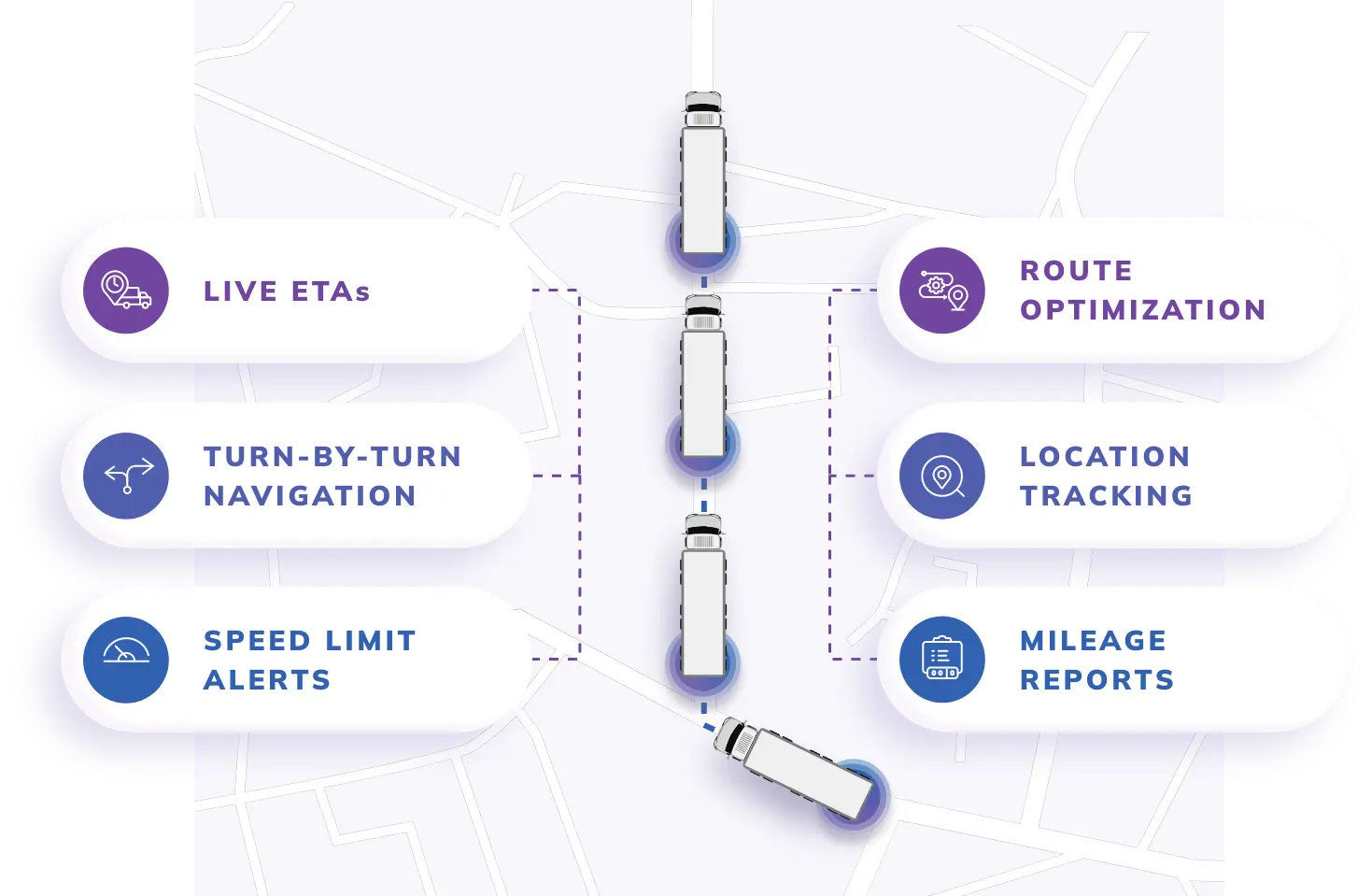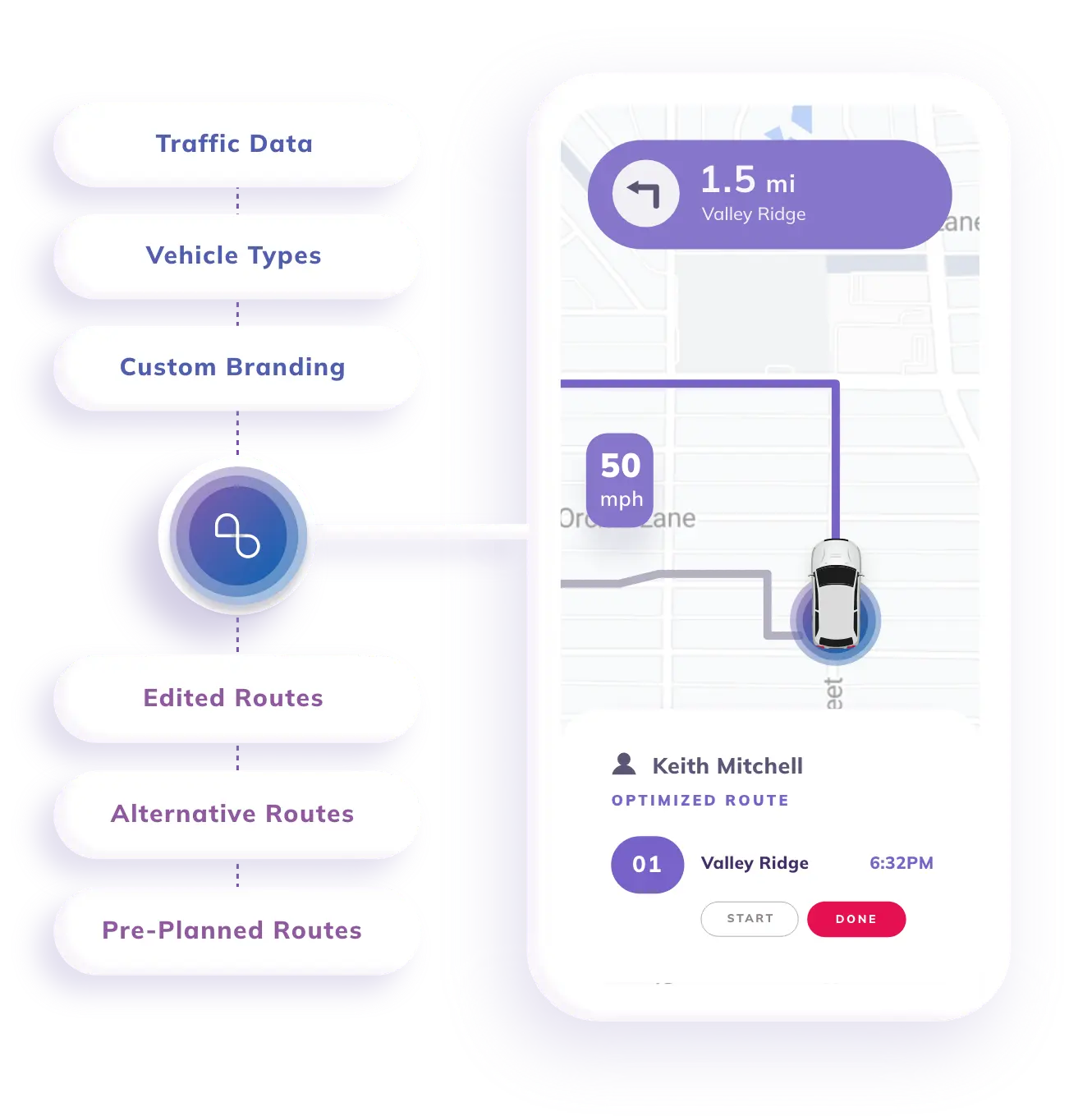

- BLOG
The Impact of Real-Time Traffic Data on Fleet Routing Efficiency
Published: August 6, 2025
Route Optimization API
Optimize routing, task allocation and dispatch
Distance Matrix API
Calculate accurate ETAs, distances and directions
Directions API
Compute routes between two locations
Driver Assignment API
Assign the best driver for every order
Routing & Dispatch App
Plan optimized routes with 50+ Constraints
Product Demos
See NextBillion.ai APIs & SDKs In action
AI Route Optimization
Learns from Your Fleet’s Past Performance
Platform Overview
Learn about how Nextbillion.ai's platform is designed
Road Editor App
Private Routing Preferences For Custom Routing
On-Premise Deployments
Take Full Control of Your Maps and Routing
Trucking
Get regulation-compliant truck routes
Fleet Management
Solve fleet tracking, routing and navigation
Middle Mile Delivery
Optimized supply chain routes
Construction
Routes for Construction Material Delivery
Oil & Gas
Safe & Compliant Routing
Food & Beverage
Plan deliveries of refrigerated goods with regular shipments
Table of Contents

For those managing fleets, the world of traditional routing exists in constant tension. The best-laid plans can only hold so much promise. Drivers are still out on the road, spending about 37.2 billion hours a year in traffic, according to the Federal Highway Administration.
As real life happens: traffic jams, accidents, road work, and weather, roads can get even more congested, especially when business is busy. On paper, the shortest route might look simple, but in reality, drivers face lots of twists, turns, and delays along the way.
Today, real-time traffic data is essential in modern fleet routing. It is no longer just a basic feature of mapping systems. For many in the industry, using live traffic data has become a must-have for running efficient and profitable logistics. In this blog, we will share a few practical insights on how this shift is shaping fleet operations.
Real-time traffic data means data that traffic is happening right now. The data that inform the map come from a number of sources. The sources are varied and increasingly sophisticated:
What we think of as “normal” traffic is always changing. Rush hour is rarely the same from day to day because so many different things affect traffic. Real-time traffic data shows what’s actually happening right now, like crashes, road closures, or bad weather, while historical data is useful for planning but doesn’t help when things suddenly change. For fleets that need to respond quickly and keep deliveries on track, real-time data is the only way to adjust in the moment.
Here’s how real-time traffic data actually shapes fleet routing:
This is the core of the dynamic routing software. Each time traffic circumstances shift, the routing engine recalibrates the optimal path for each vehicle in your fleet. If one of your drivers heads toward a newly forming traffic jam, the system perceives the slowdown, recalibrates the driver’s route, and updates their navigation in real-time. The same goes for accidents, road closures, or what meteorologists sometimes call “weather issues.”
This isn’t a theory. In the real world, where we live, work, and drive in a vehicle owned by a company, urgency thrusts us into immediacy. We have something pressing that we must do, always with the implication that we’re nearly out of time.
In several industries, time is super crucial. For example: a missed delivery in the world of medical supply, for instance, can mean that a sick person or a hospital teetering on the edge can’t be whole without a crucial part, often a critical thing in that next hour or two. No human can keep up with that and make the live recalibrations necessary to get every vehicle back on the right path. But with live traffic data, a dynamic routing solution can.
Accurate ETAs are a big deal for today’s fleets. Using the most current data, the systems make calculations based on all the factors that can affect travel time: traffic conditions, road closures, and the like. When a vehicle’s route is adjusted, so is the ETA.
Adjustments to delivery and arrival estimates are communicated live to customers and instantaneously to the dispatch team, who can then go off-script and handle the situation in the best way possible for the customer.
Real-time traffic information saves more than just time on individual journeys. It directs motorists and their cars to keep the actual traffic phenomenon flowing (no gridlock). The result is an actual time-saver for all the routes taken throughout the day. For that reason, fleet operators can expect idle time to drop, wasted hours to decline, and a remarkably improved opportunity to pick up more jobs per shift.
When it comes to availability, it’s a whole new ballgame for schedulers. They can now see when drivers will really be available, and as a result of that (and some better tools), they’re doing a better job of not overbooking. And drivers? For them, it’s a productivity increase without an increase in workload.
The takeaway: with the same number of vehicles and drivers, you do more deliveries. Every asset you own gets worked harder, generating more value than it did before.

Here are the main benefits you get when you add real-time traffic data to your fleet operations:
Delivery costs bear the main brunt of traffic, like anything relying on vehicles on the road. Fuel consumption jumps with every idle minute or wrong turn, and our vehicles rack up unnecessary miles when they get taken by surprise. Integrating real-time traffic data leads directly to lower fuel bills, because every route is optimized for current conditions, not just the shortest path on a map.
Moreover, there is also a reduction in vehicle wear and tear: less stop-and-go, fewer abrupt detours, and less time spent crawling along at low speed. This can only mean longer asset life and lower maintenance costs. Add to that the reduction in overtime penalty payments hard-pressed transit authorities must make (because drivers get where they need to be, when they ought to be there), and you have a situation where saving compounds at scale.
Dynamic-routing fleets, which expertly use live traffic data, routinely accomplish more deliveries or service calls per day. Why? Because every minute not spent in traffic can be repurposed for another job. By using these methods, the author’s operation accomplishes twice as much as it did before. In the past, “we were simply not managing our traffic time efficiently. That’s the number one thing that we’ve solved for.” Faster turnarounds at loading docks, quicker drop-offs, and less time lost between stops keep your operation lean.
Real-time, automated suggestions make dispatch operations more efficient. This allows dispatchers to not only put out fires when needed but also plan and optimize their overall operations. The smart and strategic routing software makes split-second decisions. You don’t have to worry about the software making the wrong call and needing to route everything through your main control center. Your dispatchers can focus on using the overall efficiency of your operations to serve the big picture.
Everyone dislikes waiting and unexpected occurrences during deliveries. Customers get the precise, dependable delivery windows and timely notifications about any service problems that could affect their deliveries. With these in place, the kind of service that leads to repeat business and positive reviews is virtually guaranteed. In this world, delivery reliability is now a core logistics differentiator and e-commerce winner.
Enhanced driver productivity and safety is a direct result of using real-time traffic data. Drivers spend less time stuck in stressful traffic jams, which cuts down on frustration and fatigue. They’re also steered away from the most congested and potentially hazardous spots on the road, making every trip safer. Plus, when routes are optimized in real time, it’s much easier for drivers to stick to required hours of service and other driving rules, no scrambling to catch up after a big delay. All of this means your drivers get more done, with less hassle and less risk, every day.
Here’s what it takes to put real-time traffic data to work in your fleet management system:
Not every routing engine is created equal. Look for dynamic routing software with deep, live integration of real-time traffic data. Check the provider’s data coverage (is it global or local?), how often it updates, and its proven accuracy. The best APIs are flexible, letting you integrate with your current fleet management or transportation management system (FMS/TMS) with minimal hassle.
Just having an app isn’t enough. The real need is for system compatibility. Your FMS or TMS needs to be able to “speak” directly with traffic data providers, processing the kinds of rapid data updates that a growing fleet demands.
Large infrastructure with the ability to process big data streams is essential. Yet even that is not the whole story; the modern fleet is not only bigger, it is also more connected and is procuring real-time sensors that will by themselves produce significant amounts of data. The demands on both the data traffic and on the infrastructure that supports the fleet are not going away. They are getting much larger. Much faster.
All this technology is only as good as the people using it. To work effectively with the new software and to understand the new ways of working necessitated by this technology, dispatchers and drivers must receive training that goes well beyond the mere instruction of the tools. They must learn to trust and utilize the technological decisions being made in the dispatch center, to work with the updates being received in real time at the more automated end of the spectrum, and to route plan and drive in order to best meet the expectations that are being set by the technology on both ends. Cab navigation needs to be elementary; the instructions must be clear, and the feedback must be real-time.
Here’s how NextBillion.ai fits into fleet routing powered by real-time traffic data:
NexBillion.ai offers a dynamic routing application programming interface (API) built for fleets that operate in the real world, as opposed to merely on paper. The engine taps into a comprehensive, globally sourced real-time traffic data (combining GPS probe data, municipal feeds, crowdsourced updates, weather information, and more) to ensure that routing recommendations are always current. For any fleet, anywhere, this means a routing API that works in real time no longer has to rely on time-averaged models for predicting what a route will look like over the duration of that route.
NextBillion.ai’s predictive traffic modeling is what makes it distinct. The system does not merely react to situations where there are traffic jams. It predicts that there will be traffic jams and uses historical data in combination with live feeds to project the traffic patterns of the future. If you give it a starting point and an ending point, it can suggest a route that will stay open.

Transportation networks depend on accurate timing. They need reliable arrival times, not just vague estimates. NextBillion.ai provides accurate ETAs, and that’s what makes it a next-generation solution.
NextBillion.ai’s ETAs use live traffic for the best accuracy. So, when a big fleet of delivery vans needs to get somewhere on time, not simply close to on time, it can work with NextBillion.ai’s estimates and know that what it’s working with is the best and most accurate estimate.
All fleets are not the same, and NextBillion.ai builds flexibility into its offering. Logistics fleets need to minimize fuel use and maximize stops per hour. Ride-hailing operators depend on live ETAs and rapid route updates for passenger satisfaction. Field service teams need to avoid idle time and keep technician schedules tight.
NextBillion.ai’s platform can be tailored to each use case, whether your operation runs dozens of vans in a metro area, thousands of trucks cross-country, or hundreds of on-demand cars in a city center. Scalability and customization aren’t afterthoughts; they are at the core.
NextBillion.ai is the right choice for several reasons. First and foremost, it offers enterprise-grade reliability. You can count on uptime, global data coverage, and consistent, large-scale performance that is built right into the product.
Next, consider the pay-as-you-go pricing model, which is refreshing compared to many other options in the market. You’re not locked into huge upfront contracts or bound by any sort of inflexible pricing.
Finally, the data quality is simply top-notch. NextBillion.ai is not shy about investing in first-rate data sources, and that’s great for you, the end user.
Fleets that continue to depend on static routing or that seem oblivious to real-time traffic are just throwing money away. The contrast is plain: fleets that use live traffic data are reaping the benefits in the form of shorter delivery windows, better customer satisfaction, and, most notably, fewer complaints and lower fuel bills (the two metrics that determine the state of trucking in every customer’s eyes). This isn’t about the latest dispatch buzzword or a fancy gadget. It’s about dispatching with a purpose and driving with a plan, day after day.
Fleet routing is a must for any business that runs a fleet, and it serves the dual purposes of saving money and making customers happier. The routing is especially important when that fleet is made up of very large vehicles and when the path those vehicles must take is very tightly constrained, whether because of urban congestion or road design. Overall, a fleet-routing algorithm is a system design that aims to solve the following two key questions:
Real-time traffic data allows fleet vehicles to avoid congestion, accidents, and closures, directly reducing travel times and late deliveries. Traffic data is obtained from many various sources. And those source are:
And from these data sets we can understand what is happening on the road.
Historical data helps with baseline planning, showing typical conditions at set times and locations. Real-time data reflects what’s happening right now, allowing fleets to adjust instantly and avoid the pitfalls of relying on “average” traffic conditions.
Yes. Fleets using live traffic data report significant savings through lower fuel usage, less overtime, fewer vehicle breakdowns, and improved scheduling, all from minimizing time lost to traffic.
NextBillion.ai and leading providers offer global coverage, but data density and accuracy may vary by region. Always check that your solution’s data sources are strong where you operate.
Bhavisha Bhatia is a Computer Science graduate with a passion for writing technical blogs that make complex technical concepts engaging and easy to understand. She is intrigued by the technological developments shaping the course of the world and the beautiful nature around us.